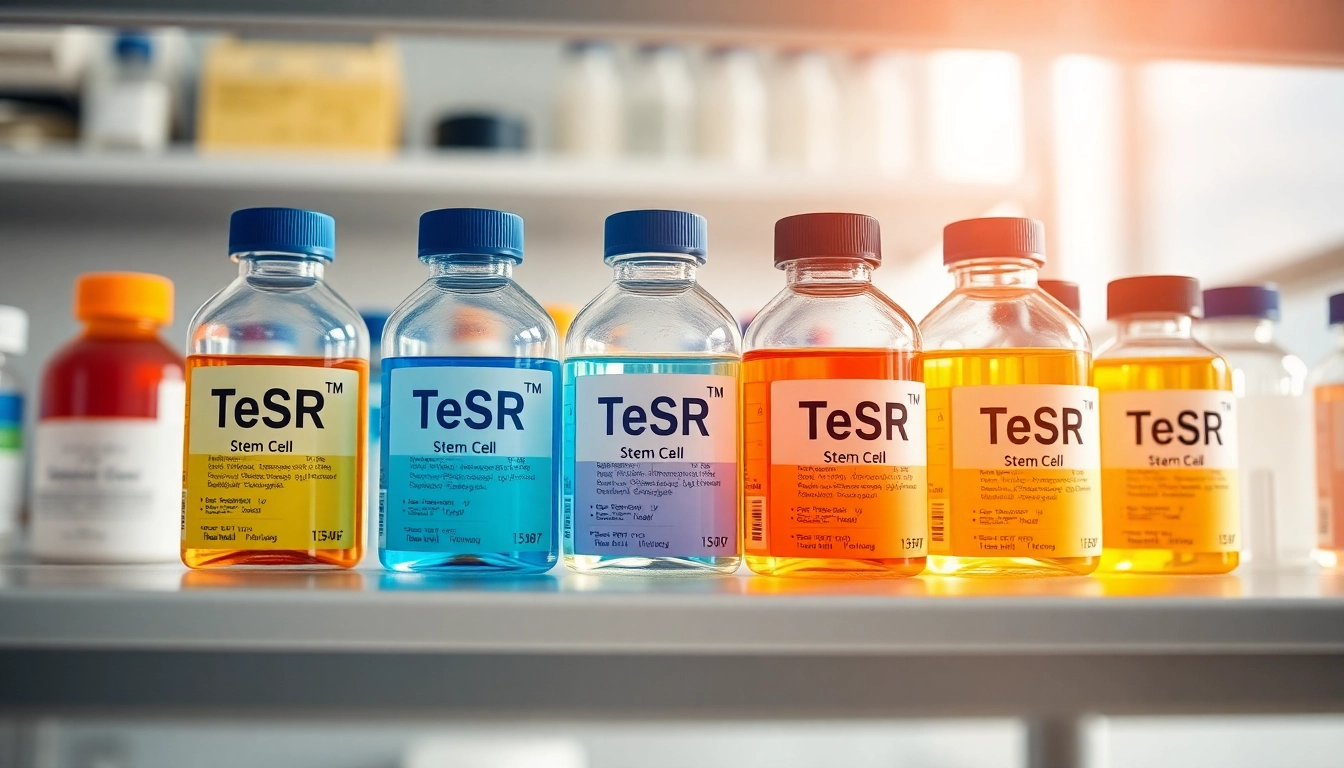Understanding TeSR™ Feeder-Free Media
In the world of stem cell research, choosing the right culture medium is crucial to achieving successful outcomes. TeSR™ feeder-free media, developed by STEMCELL Technologies, are leading the way in providing a viable and effective platform for maintaining human embryonic and induced pluripotent stem cells (hPSCs). These sophisticated media support the entire journey of stem cell research, from cell reprogramming to differentiation and cryopreservation. To understand the significance of these media, let’s explore what they are, their benefits, and their applications in various sectors of stem cell research. The comprehensive range of TeSR™ media includes options like all check for personalized needs in this fast-evolving field.
What is TeSR™ Media?
TeSR™ media is a family of defined, feeder-free culture media specifically formulated to support the growth and maintenance of hPSCs. This product line originated from groundbreaking work done in Dr. James Thomson’s laboratory, where researchers first derived stem cells under fully defined conditions in 2006. Since then, various adaptations of TeSR™ media have been released, enhancing cell growth conditions and ensuring reproducibility in experiments.
The media consist of essential nutrients, cytokines, and salts that contribute to the optimal growth environment. Each formulation within the TeSR™ lineup is developed based on published scientific research, ensuring that they are backed by robust data and meet the stringent requirements of modern cell culture techniques.
Key Advantages of Feeder-Free Culture
The move toward feeder-free culture systems, particularly using TeSR™ media, provides several notable advantages:
- Reduced Contamination Risks: Feeder cells can introduce variability and risk of contamination; using a defined medium minimizes these hazards.
- Enhanced Reproducibility: TeSR™ media promote consistent growth and maintenance of hPSCs, which is critical for deriving reliable experimental results.
- Streamlined Differentiation: These media are designed to ease the process of transitioning stem cells from a pluripotent state to specific differentiated lineages, one of the significant challenges in stem cell biology.
- Regulatory Compliance: Many TeSR™ products are developed under cGMP conditions, which ensure that they are safe and effective for research and potential clinical applications.
Applications in Stem Cell Research
TeSR™ media are employed in a variety of applications within stem cell research, including:
- Induced Pluripotent Stem Cell (iPSC) Reprogramming: TeSR™ media support the transformation of somatic cells into iPSCs, which are valuable for personalized medicine and regenerative therapies.
- Maintenance of Pluripotency: These media keep stem cells in an undifferentiated state, allowing for multiple passages without losing their stemness.
- Directed Differentiation: Researchers use specific formulations within the TeSR™ family to guide stem cells towards desired cell lineages, such as cardiomyocytes or neurons.
- Cryopreservation: TeSR™ derived media, including mFreSR™, provide optimal conditions for the freezing and thawing of hPSCs, crucial for long-term storage.
Comparative Analysis of TeSR™ Media Varieties
Overview of mTeSR™ and eTeSR™
The TeSR™ media family encompasses a variety of formulations tailored for different needs. mTeSR™1, the original formulation, has paved the way for subsequent products by providing a robust foundation for maintaining hPSCs. Its low protein and defined composition enhance reproducibility across experiments. In contrast, eTeSR™ is a xeno-free alternative that ensures no animal-derived components, appealing to researchers focused on translational medicine.
Exploring TeSR™-AOF and mTeSR™ Plus
TeSR™-AOF (Animal Origin-Free) takes the commitment to safety a step further, offering a medium guaranteed to be free from both human and animal materials. This is especially vital in research areas with concerns surrounding viral contamination.
On the other hand, mTeSR™ Plus is a more recently developed formulation designed for high-throughput and clinical applications. Its unique features include:
- Stabilized Components: Enhanced buffering systems minimize acidification during culture, allowing for skipped media changes without compromising cell quality.
- cGMP Compliance: Manufactured under relevant GMP conditions, it is suitable for potential clinical applications, providing peace of mind for researchers moving towards therapies.
Choosing the Right Medium for Your Research
Selecting the appropriate TeSR™ medium depends on your specific research objectives. For those focused on basic research, mTeSR™1 or eTeSR™ may be sufficient for maintaining hPSCs. However, for applications such as therapeutic development or high-volume research, mTeSR™ Plus and TeSR™-AOF are recommended due to their enhanced properties and regulatory compliance.
For differentiation protocols or cryopreservation, you might consider specialized formulations like TeSR™-E6 or ReproTeSR™ for reprogramming fibroblasts and blood cells.
Best Practices for Using TeSR™ Media
Maintaining Consistency in Cultures
Consistency in cell culture is vital for reliable experimental outcomes. Adhering to best practices in handling and using TeSR™ media can significantly reduce variability:
- Aseptic Technique: Always employ aseptic techniques during media preparation and cell passaging to prevent contamination.
- Regular Monitoring: Regularly assess the pH and osmolality of your cultures, especially when using mTeSR™ Plus, to ensure optimal growth conditions.
- Proper Passaging: Follow recommended passaging techniques to maintain a healthy cell line, avoiding over-confluence which can lead to differentiation.
Handling and Storage Recommendations
Proper handling and storage of TeSR™ media are essential for maintaining their integrity and effectiveness:
- Storage Conditions: Store media as per manufacturer guidelines, usually at -20°C for long-term use. Avoid repeated freeze-thaw cycles.
- Shelf Life: Be mindful of the expiration dates and use the media before they expire to guarantee optimal performance.
Common Pitfalls and Solutions
Researchers may encounter common challenges while using TeSR™ media. Here are some potential pitfalls along with their solutions:
- Cell Contamination: Implement rigorous aseptic techniques; regularly clean work surfaces and use proper sterile tools.
- Unreliable Growth: Ensure the media is fresh and has been thawed and mixed thoroughly before use, as precise composition is essential for cellular growth.
- Cell Differentiation: Regularly check for signs of differentiation; ensuring correct passaging and using proper media for your specific cell type can help maintain pluripotency.
Insights from Leading Experts
Insights From Dr. Joseph C. Wu on Hematopoietic Cells
Dr. Joseph C. Wu emphasizes the importance of using high-quality media like TeSR™ for the successful differentiation of hPSCs into hematopoietic cells. He notes that the precision in media formulation significantly impacts cell lineage commitment, improving rates of successful differentiation, essential for therapies like blood disorders.
Expert Tips from Dr. Christine Mummery on Cardiomyocyte Differentiation
In her work, Dr. Christine Mummery highlights that using specialized differentiation media within the TeSR™ lineup allows for the efficient generation of cardiomyocytes from hPSCs. She advises rigorous monitoring and adjusting media compositions during differentiation to ensure optimal expression of cardiac markers.
Dr. Andrew Elefanty’s Perspective on Endoderm Differentiation
Dr. Andrew Elefanty’s insights stress the significant role TeSR™ media play in advancing endoderm differentiation. He mentions that innovations in the formulations have provided researchers the tools necessary to unlock new avenues for therapeutic applications, particularly in gastrointestinal disorders.
The Future of Feeder-Free Stem Cell Research
Emerging Trends in Stem Cell Culture
The landscape of stem cell research is ever-evolving, with trends indicating a growing preference for feeder-free systems. The introduction of innovative media formulations, such as TeSR™-E8™ and mTeSR™ Plus, signify a shift toward enhancing the practicality of these media for clinical applications.
Innovative Applications of TeSR™ Media
Researchers are finding novel applications for TeSR™ media beyond traditional stem cell cultures. For example, combining TeSR™ media with advanced bioreactor systems provides an efficient pathway for scaling stem cell production, crucial for large-scale therapeutic applications.
Potential Challenges and Opportunities Ahead
While the advantages of TeSR™ feeder-free media are clear, challenges remain, such as maintaining quality control across different applications and ensuring scalability for therapeutic uses. The continuous feedback from the scientific community and advancements in technology hold the key to addressing these challenges effectively.



